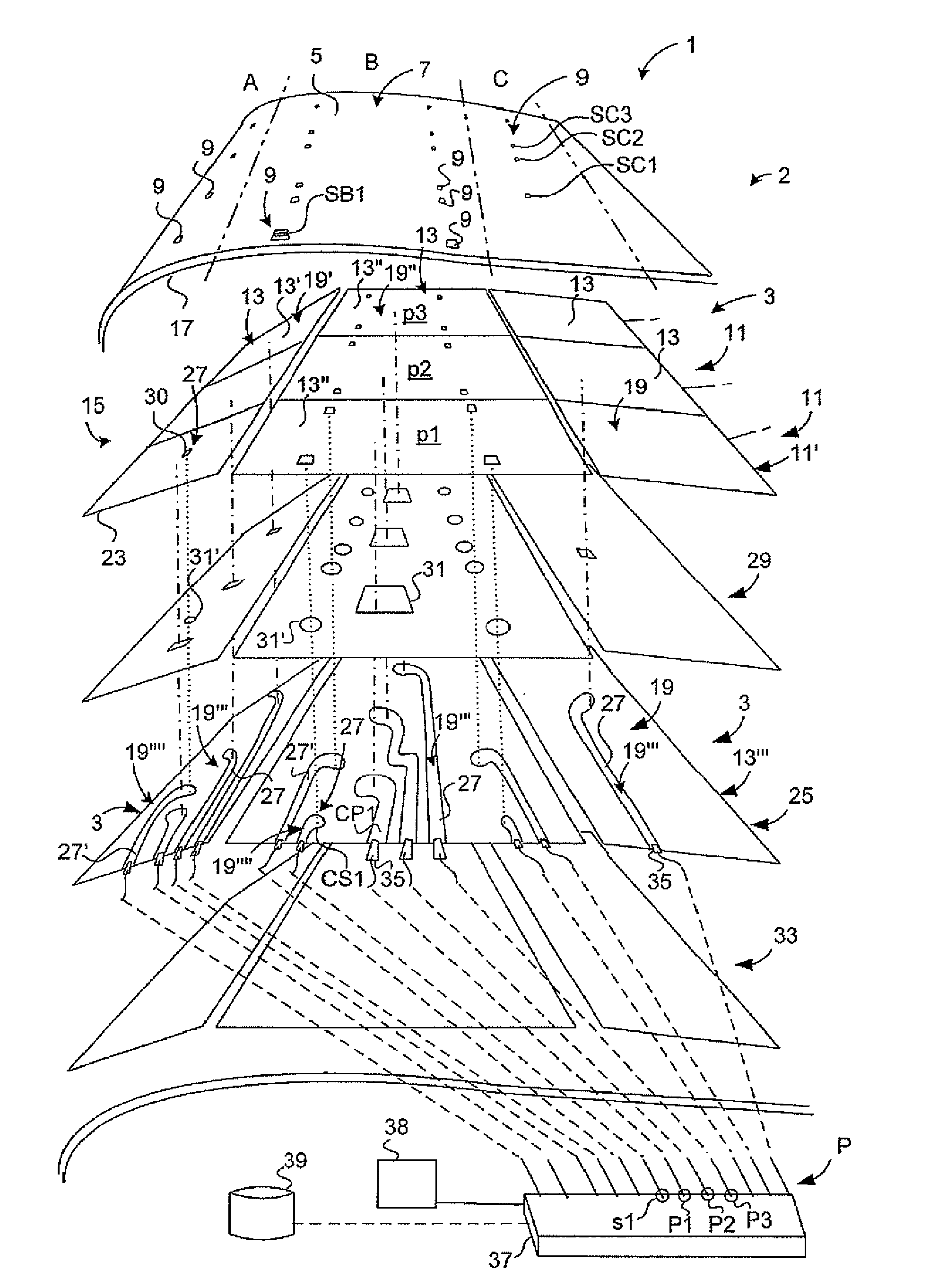Multifunctional de-icing/Anti-icing system of a wind turbine
a wind turbine and multi-functional technology, applied in the direction of rotors, marine propulsion, vessel construction, etc., can solve the problems of low energy loss and low power consumption of melting ice, and achieve the effect of reducing the weight of articles and saving weigh
- Summary
- Abstract
- Description
- Claims
- Application Information
AI Technical Summary
Benefits of technology
Problems solved by technology
Method used
Image
Examples
first embodiment
[0081]FIG. 1 schematically illustrates a de-icing / anti-icing system (system 1) according to a The illustration shows parts of the embodiment essential for understanding only. The system 1 comprises a wind turbine blade 2 including a plurality of conductive structures 3 embedded in a wind turbine blade shell. The shell includes an outer surface 5 being designed as an aerodynamic surface. The outer surface 5 thus serves as the aerodynamic surface, when the shell moves relatively the air or through the air. The outer surface 5 is a hard smooth surface of a lightning protection layer 7. The smoothness and hardness of the outer surface 5 are achieved by incorporating nano structure filaments at least into the outer surface, which nano structure also is conductive and acts for shielding the wind turbine blade's interior from an eventual lightning strike. The outer surface 5 further comprises sensors 9 for detection of ice. Several sets 11 of conductive structures 3 (heating elements 13 i...
second embodiment
[0087]FIG. 2 illustrates schematically a de-icing / anti-icing system 1 according to a In this case the system 1 comprises five conductive structures 3′, 3″, 3′″, 3″″, 3′″″, each having a conductive nano structure 19, further explained below (see FIG. 3). A shorter heating conductor 27′ of conductive nano structure 19′ in an elongated resin layer extends to and is in contact with an upper inner heating element 13′. A longer heating conductor 27″ of conductive nano structure 19″ extends to an upper outer heating element 13″. Each of the heating element 13′, 13″ is divided in two sections, each arranged for area A and area B respectively. This is made by arranging leaning conductive nano filaments (area B) and transversal (area A) conductive nano filaments (See also FIG. 3). A control unit 39 controls the current supply (on / off) to the respective heating element 13′, 13″ via switches 40 and electrical wires. Due to the higher electric resistance of the area A conductive nano structure ...
third embodiment
[0089]FIG. 4 schematically illustrates a de-icing / anti-icing system 1 according to a wind power station. The system 1 comprises a control unit 39 controlling the current supply via electrical wires to a de-icing / anti-icing heating element including one conductive structure 3′ comprising a first conductive nano structure 19′ and another conductive structure 3″ including a second conductive nano structure 19″. The two conductive structures 3′, 3″ have different functionality and different conductive properties due to the architecture of the conductive nano structure 19′, 19″ in respective conductive structure 3′, 3″. The control unit 39 controls the energy supply to the de-icing / anti-icing heating element by regulating the current level. By means of different electric resistance achieved by different orientations of the conductive nano structures 19′, 19″, heat of different temperature will be produced by each conductive structure 3′, 3″.
[0090]FIG. 5 schematically illustrates a wind t...
PUM
 Login to View More
Login to View More Abstract
Description
Claims
Application Information
 Login to View More
Login to View More - R&D
- Intellectual Property
- Life Sciences
- Materials
- Tech Scout
- Unparalleled Data Quality
- Higher Quality Content
- 60% Fewer Hallucinations
Browse by: Latest US Patents, China's latest patents, Technical Efficacy Thesaurus, Application Domain, Technology Topic, Popular Technical Reports.
© 2025 PatSnap. All rights reserved.Legal|Privacy policy|Modern Slavery Act Transparency Statement|Sitemap|About US| Contact US: help@patsnap.com



